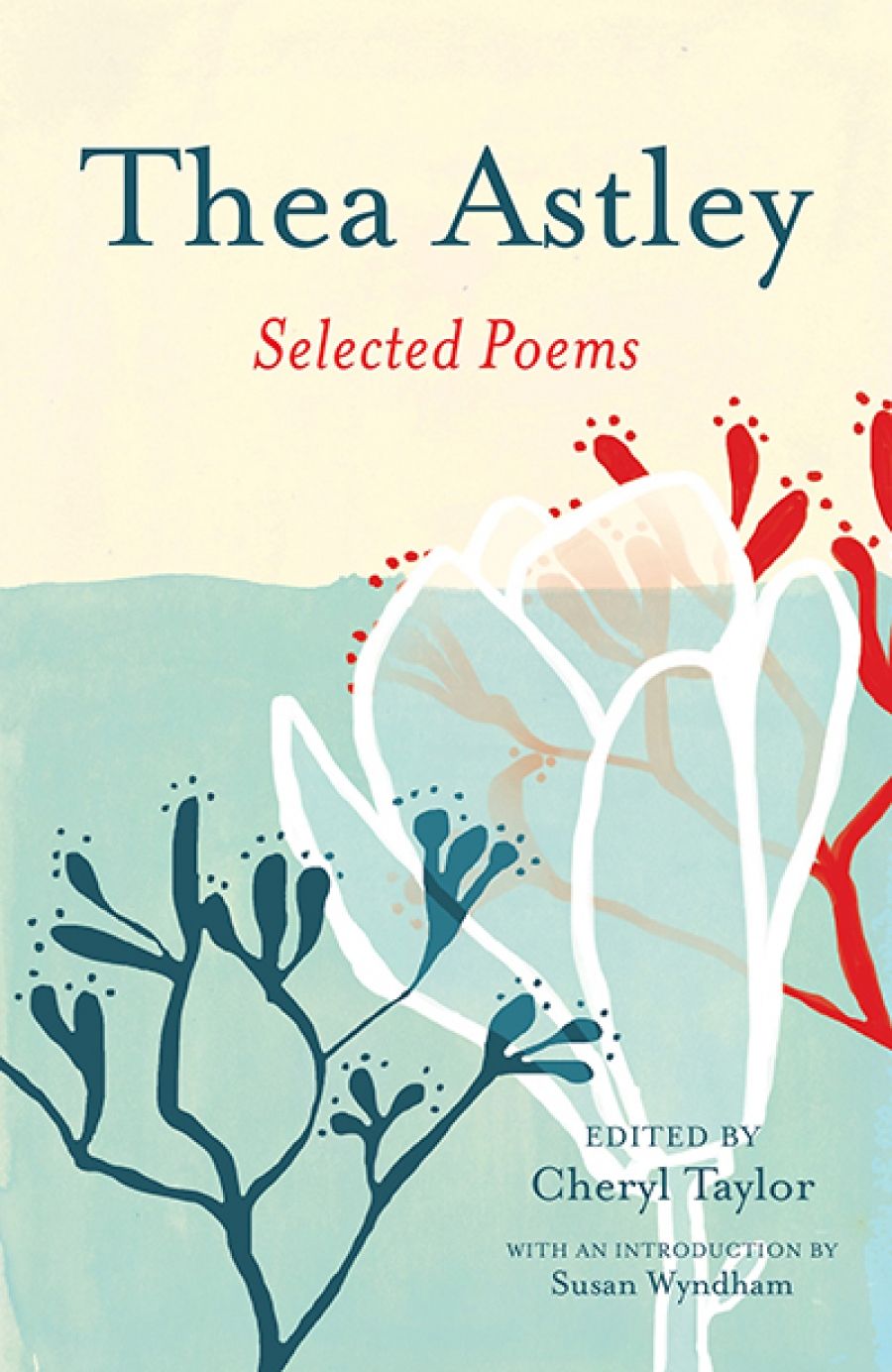
- Free Article: No
- Contents Category: Poetry
- Custom Article Title: Susan Sheridan reviews 'Thea Astley: Selected poems' edited by Cheryl Taylor
- Review Article: Yes
- Online Only: No
- Custom Highlight Text:
Thea Astley had a way with words. Her novels are studded with arresting metaphors, atrocious puns, hilarious one-liners, arcane words, technical terms from music, geometry and logic, religious and literary allusions. Her verbal pyrotechnics can be dazzling and infuriating, in equal measure: as Helen Garner once wrote, it is ...
- Book 1 Title: Thea Astley
- Book 1 Subtitle: Selected poems
- Book 1 Biblio: University of Queensland Press, $24.95, 176 pp, 978072259791
The schoolgirl poems, rightly characterised by Taylor as ‘romantic effusions influenced by Wordsworth’s and Hopkins’s nature mysticism’, give way to tentative love poems during her university years. Sexual attraction is treacherous, as in ‘From Troy’, where ‘the love of a woman’s heart’ celebrated in the first part, ‘for Oenone’, becomes a curse in the second part, ‘for Helen’. Poems addressed to Laurence Collinson, the gay poet and painter whom she met in the Barjai group of young Brisbane writers, suggest attraction unreciprocated but also valued affinities. Themes of love, abandonment, loneliness, conflict are contained in translations from French and Latin, and in her experiments with the Shakespearean sonnet. There are traces of T.S. Eliot’s city visions (‘in the streets / Night flowed its deep rivers, where traffic gleamed by ...’) and of her later fascination with chance encounters (‘A woman sat beside me in the train ...’).
The second section contains the work of the mature writer. It includes poems of passion fulfilled, dating from her marriage, like ‘You are my quiet music, you / My house roof under rain’. More often the poems have an ironic cast, like ‘Love in our time’: ‘Question and answer in the flesh, / Reducing to a brief schedule / Form-to-be-filled-relationship / Woman with man’.
Occasionally Astley used her poems in her novels, and there too their lyrical impulse is ironically placed, by commentary or context. In Girl with a Monkey, when Elsie quotes from her own poem, ‘This is a day for birds to cut with arcs / Wind-shifting geometry in upper sky / Tangent upon a dried-out shell of moon’, her road-builder boyfriend asks, to her disgust, ‘Is it Shakespeare?’ And in her last book, Drylands (1999), the storyteller Janet, who wanted to write like Schubert’s music, ‘so poised, walking the tightrope between the wet eye, the upcurled mouth’, quotes from an Astley poem that attempts exactly this kind of poise – and rejects it as ‘pretentious’.
Placing lyrical moments in a narrative context, or attaching them to a character or a dramatic encounter, suited Astley’s novelist sensibility. As they stand, the poems sometimes seem emotionally constrained by their formality, and in them she rarely gives rein to her capacity for the vernacular, and for shifting register from the sublime to the corblimey that often shocks and delights in her prose. Here’s a stanza that does effect such a shift:
You may be sure I know my neap
Washes you in antipodal tides,
Drawn by moons as gold as grins
Of amusement parks on harbour-sides ...
(‘Neap’)
The most interesting and accomplished of the poems in the second section come from a collection of forty-three which, Taylor tells us, Astley intended for publication. She had gathered them together in a special notebook in the late 1950s, when she was beginning to establish herself as a novelist (Girl with a Monkey was published in 1958, Descant for Gossips in 1960). This project was abandoned. Why? With typical self-denigration Astley labelled the notebook ‘mostly rejects’, but a fair number were published in the Sydney Morning Herald and the ABC Weekly. The collection may have been made at the suggestion of Beatrice Davis, her editor at Angus & Robertson, the publishing house responsible for most of the books of poetry that appeared in Australia at that time. But Astley’s collection of forty-three poems would have been probably too small to interest publishers in the days before paperbacks made it feasible to publish such slim volumes of verse.
 Thea Astley (Wikimedia Commons)If Astley had published this collection of poems at the end of the 1950s, what sort of reception might it have met, in the context of Australian poetry at mid-century? She herself would no doubt have compared her work most critically with that of Kenneth Slessor and A.D. Hope. In the 1950s, those ‘years of the poets’ (as Vincent Buckley called them), the standard was high. A single year, 1955, saw the publication of Hope’s The Wandering Islands, Judith Wright’s The Two Fires, and Rosemary Dobson’s Child with a Cockatoo.
Thea Astley (Wikimedia Commons)If Astley had published this collection of poems at the end of the 1950s, what sort of reception might it have met, in the context of Australian poetry at mid-century? She herself would no doubt have compared her work most critically with that of Kenneth Slessor and A.D. Hope. In the 1950s, those ‘years of the poets’ (as Vincent Buckley called them), the standard was high. A single year, 1955, saw the publication of Hope’s The Wandering Islands, Judith Wright’s The Two Fires, and Rosemary Dobson’s Child with a Cockatoo.
Astley told an interviewer that she had made the conscious decision to abandon poetry for prose when she realised that she would ‘never be any good as a poet of any stature’. In the event, the world has profited greatly from her devoting her writing life to those extraordinary novels and stories, and the fiction in turn profited from her apprenticeship in poetry.


Comments powered by CComment